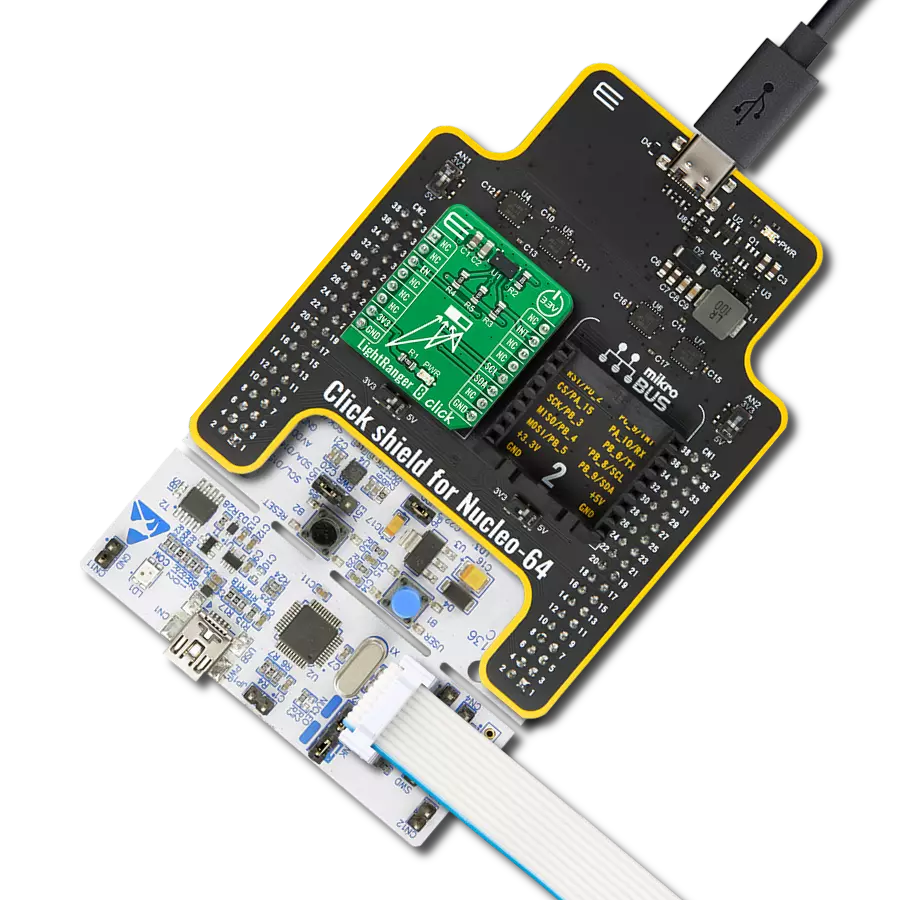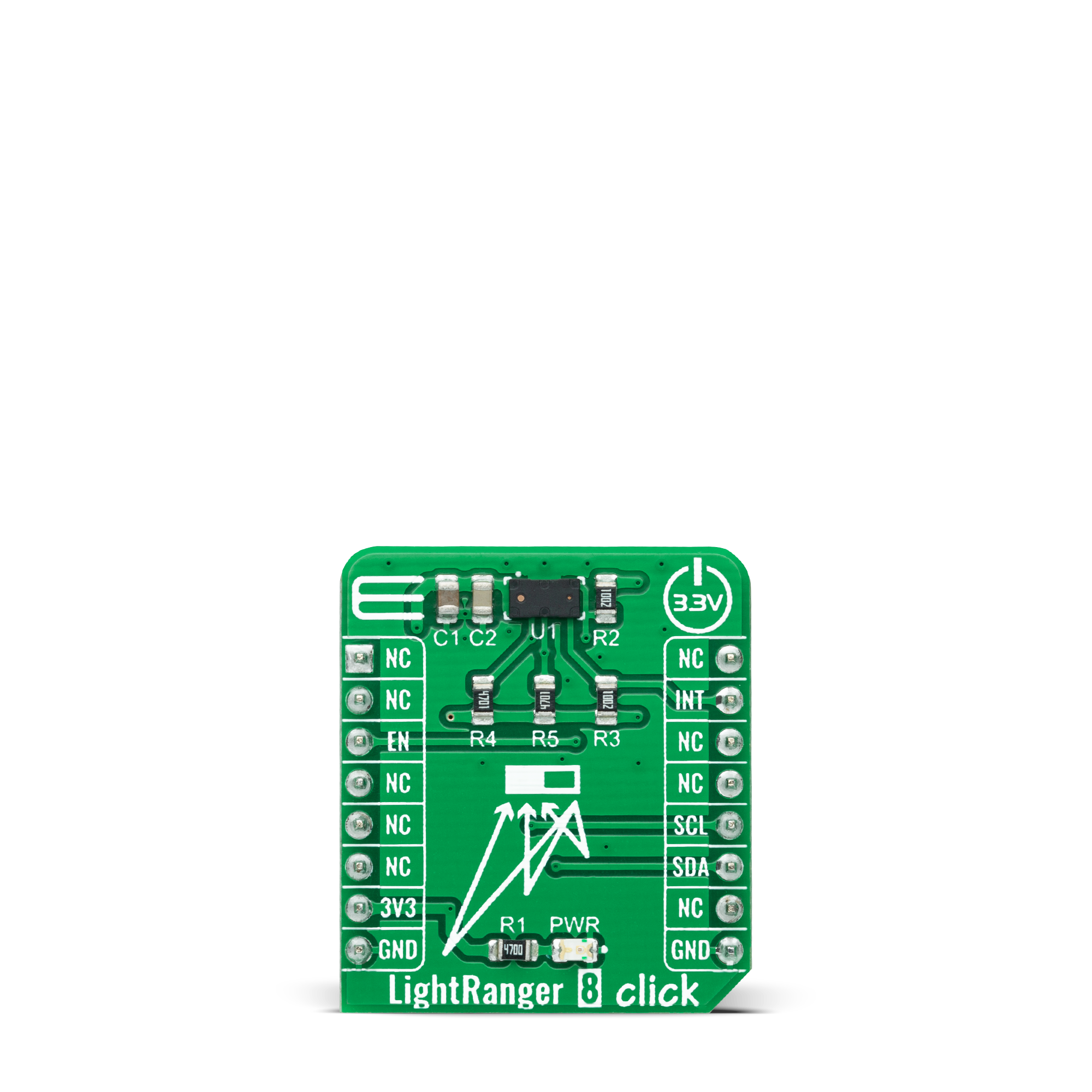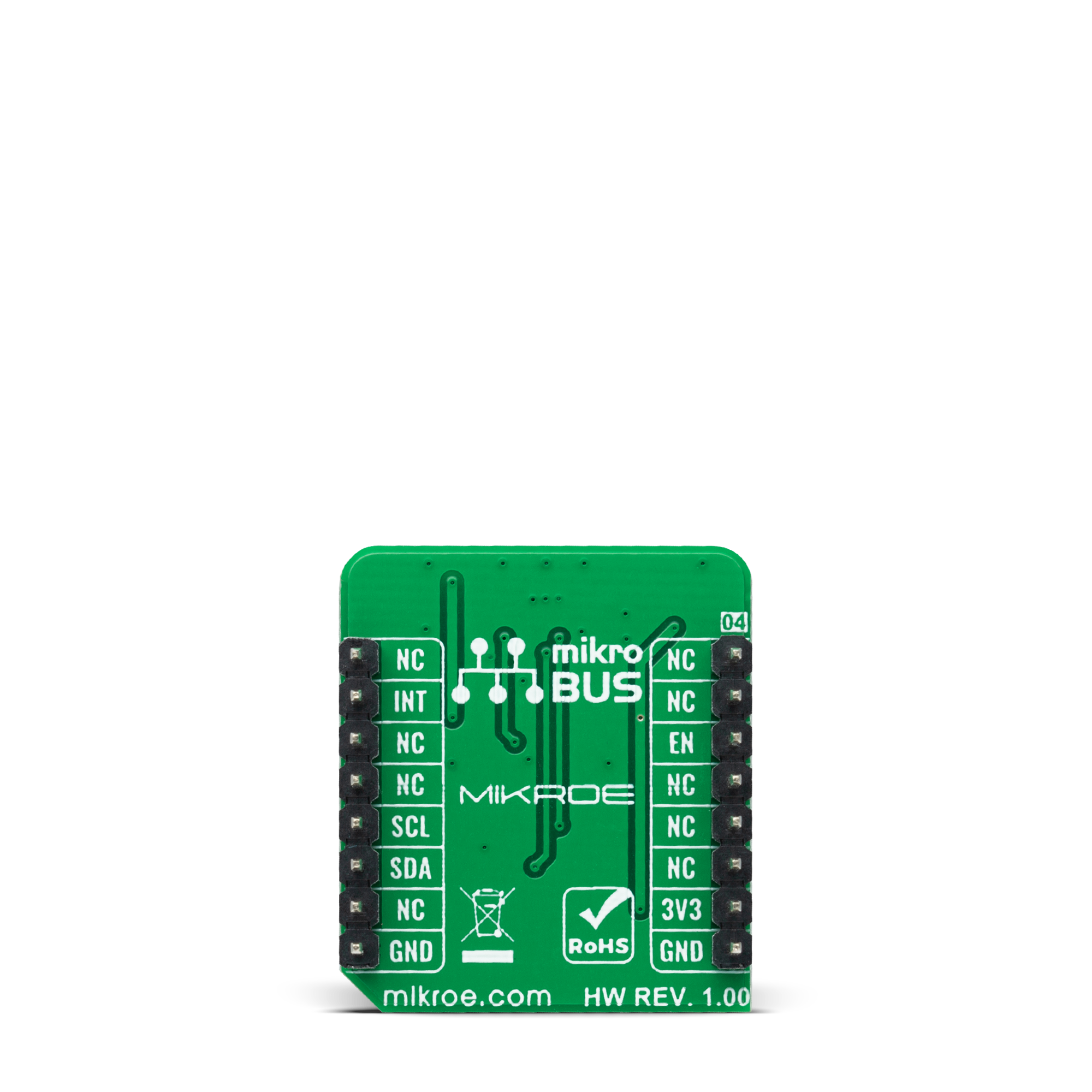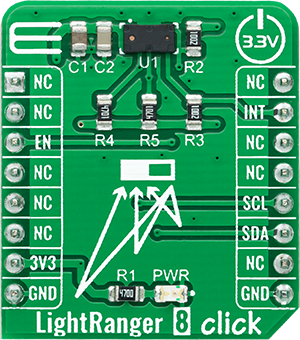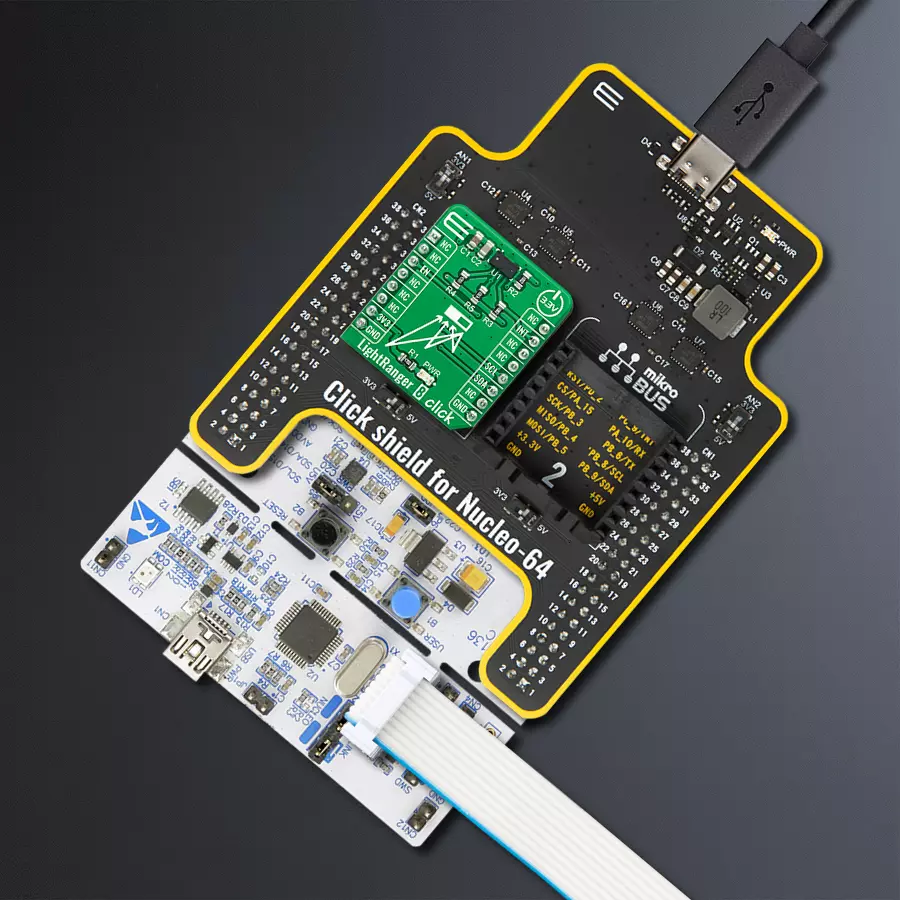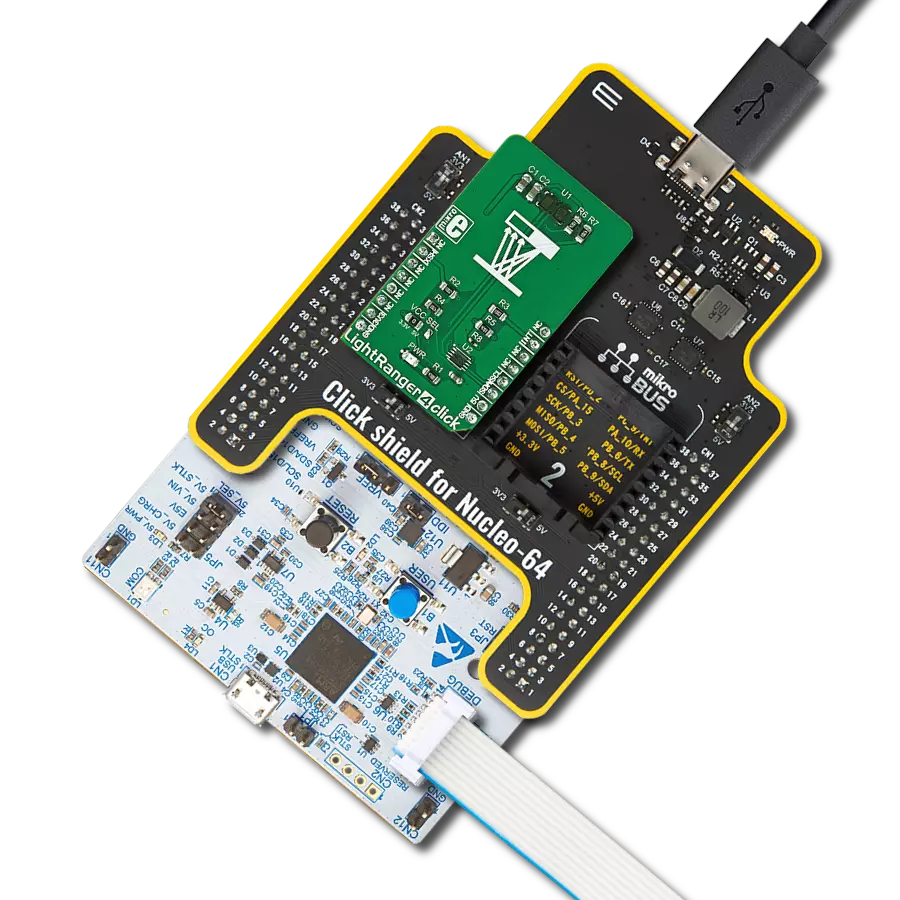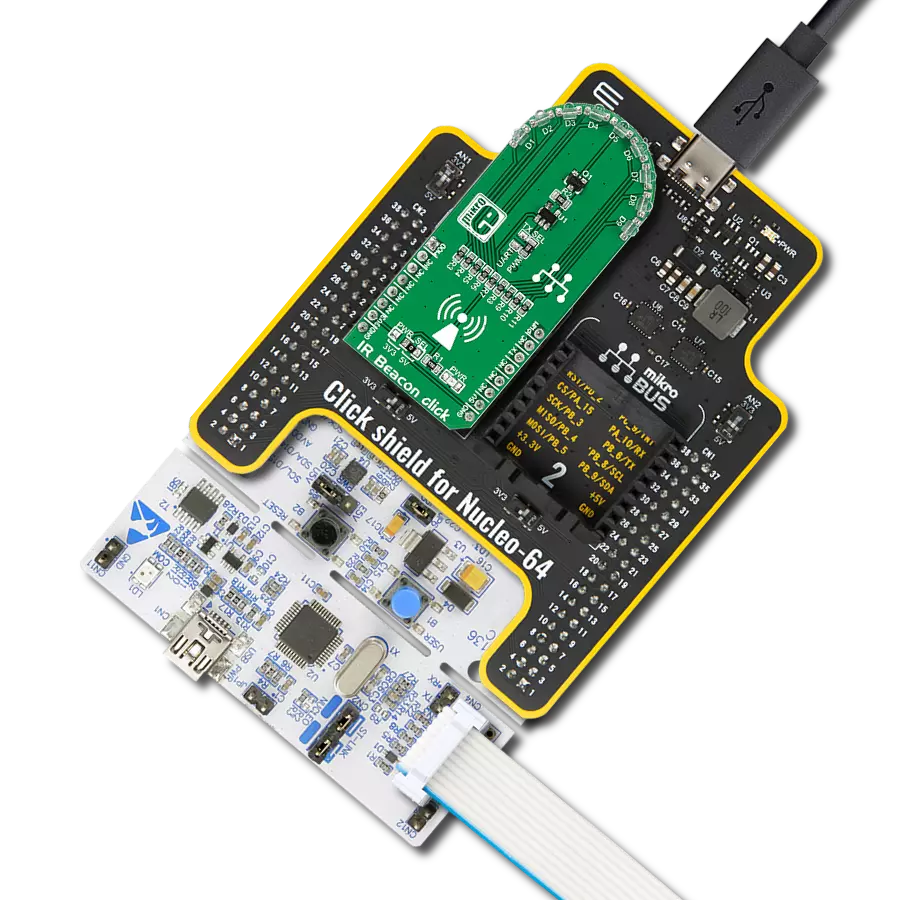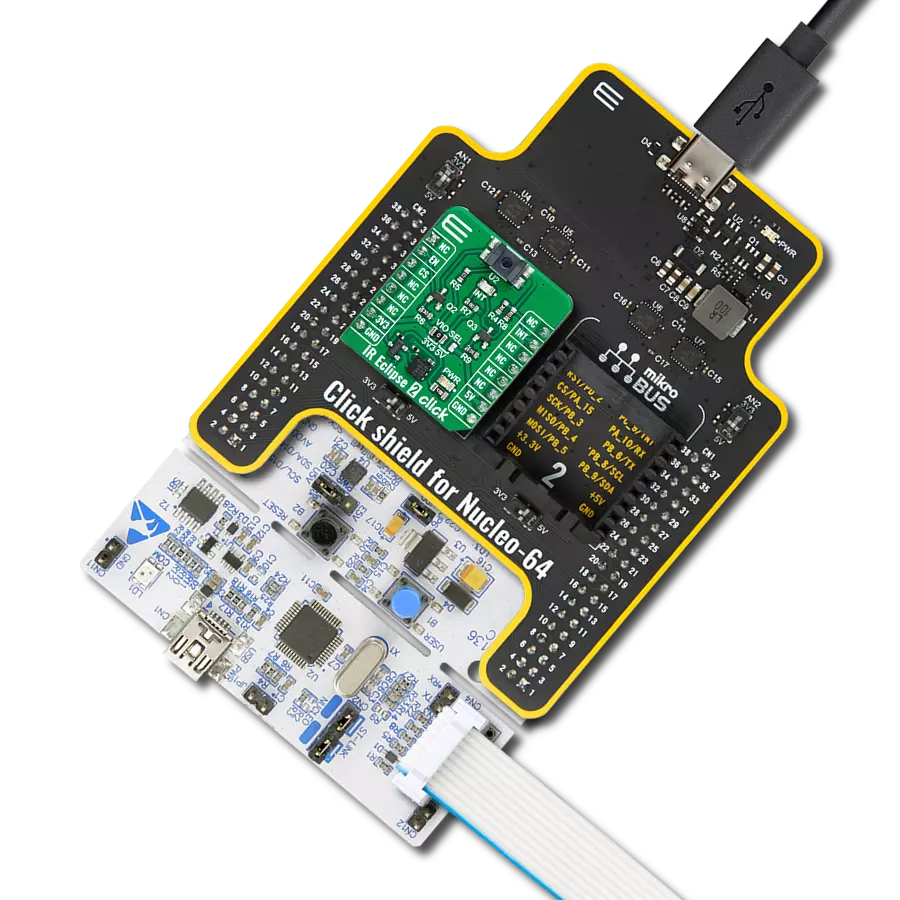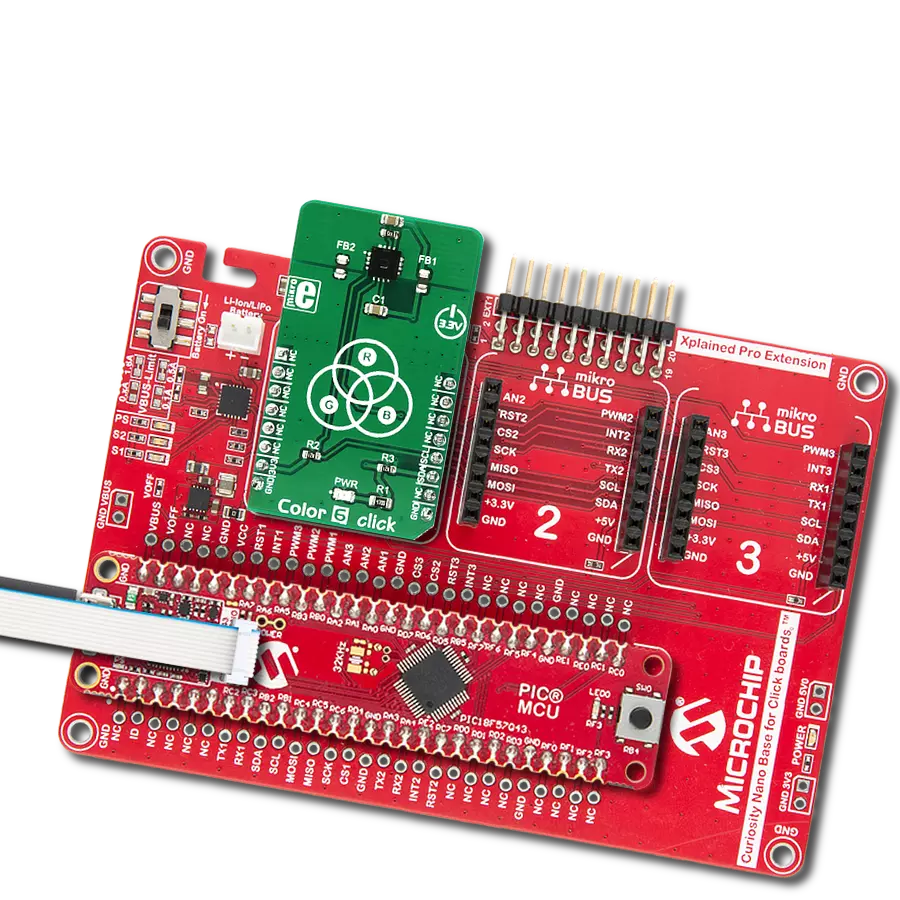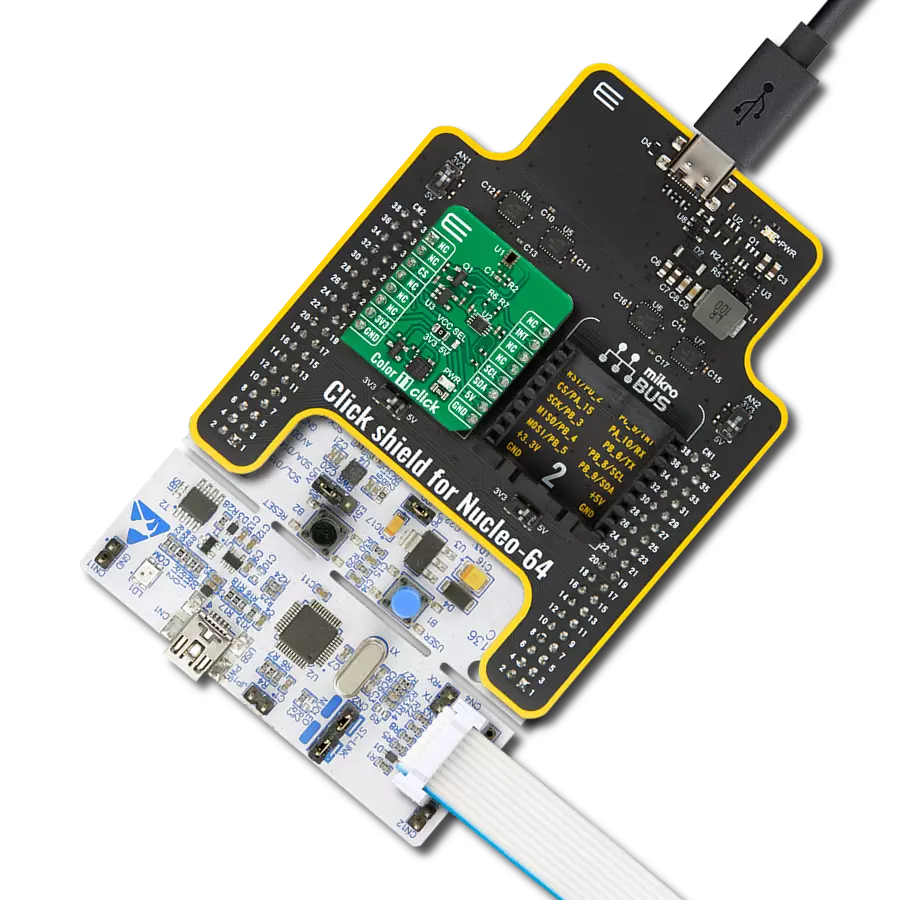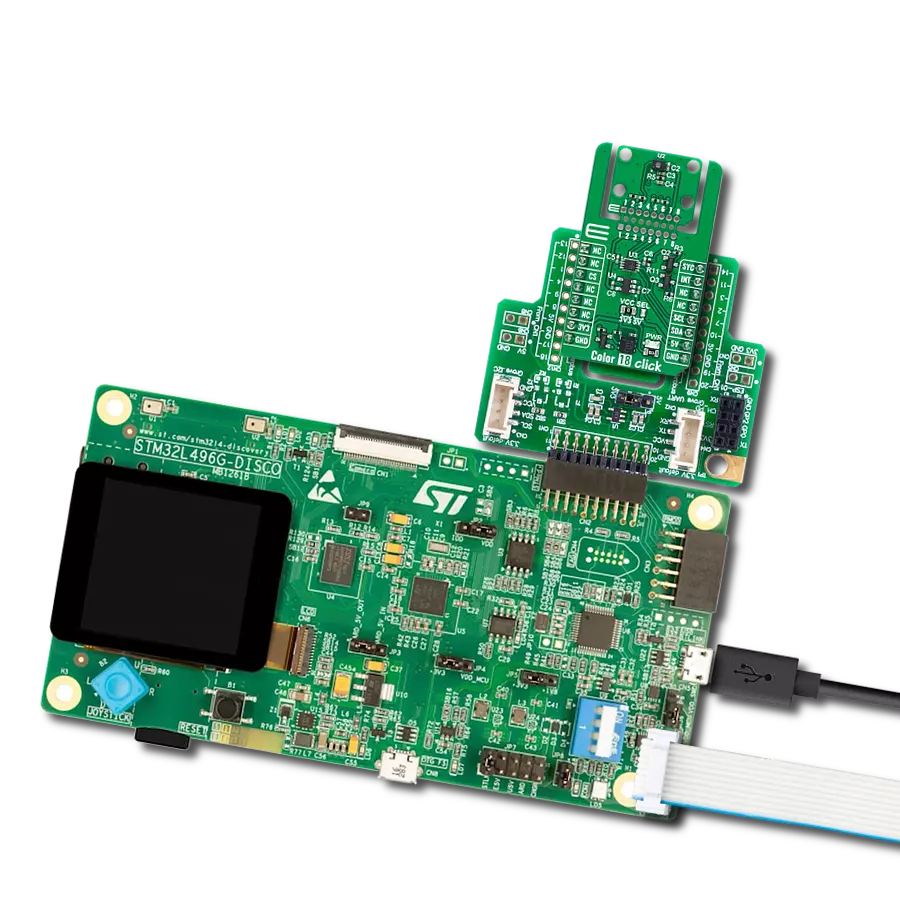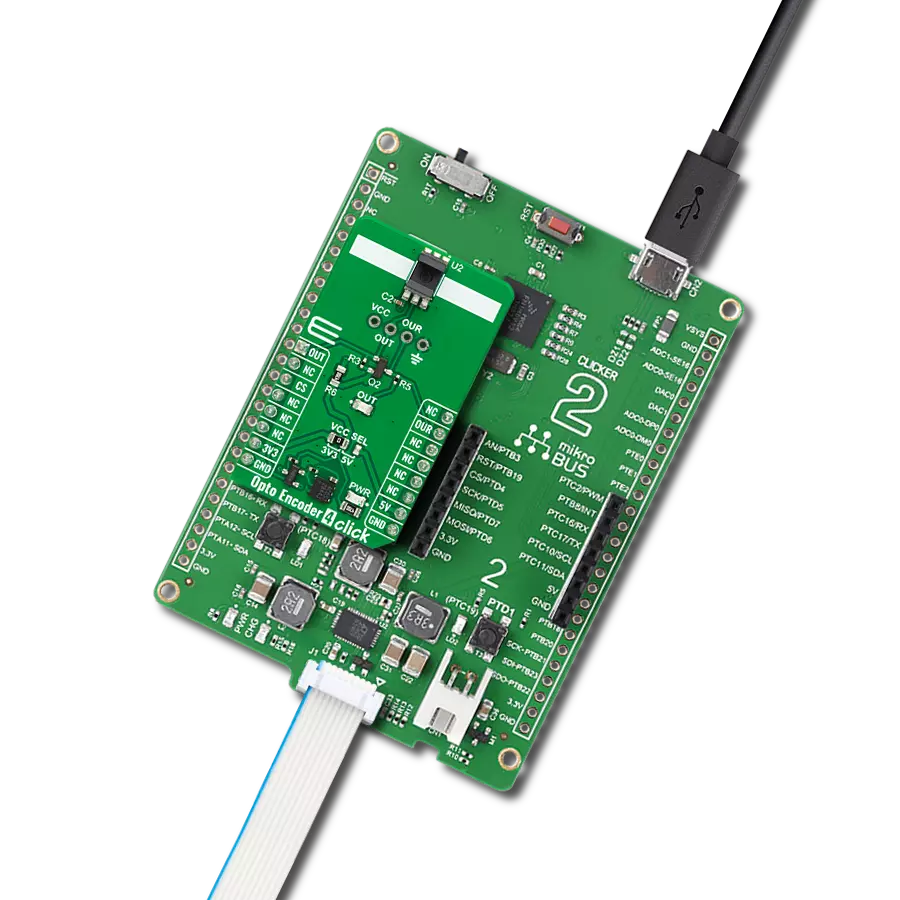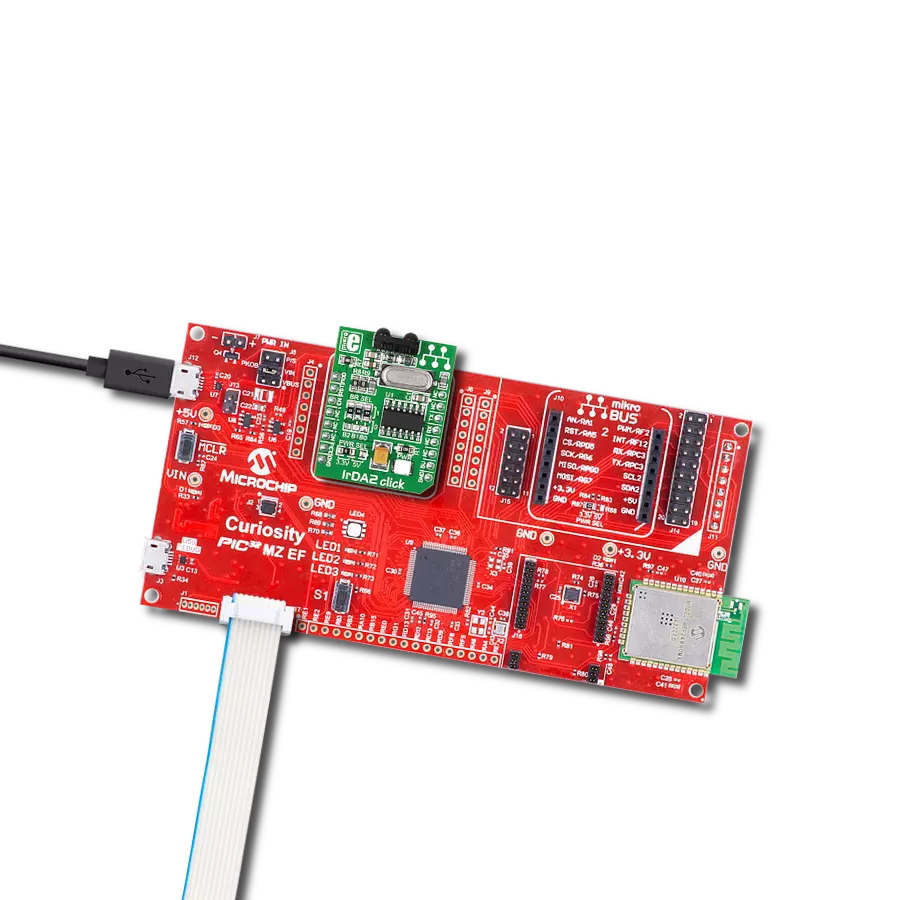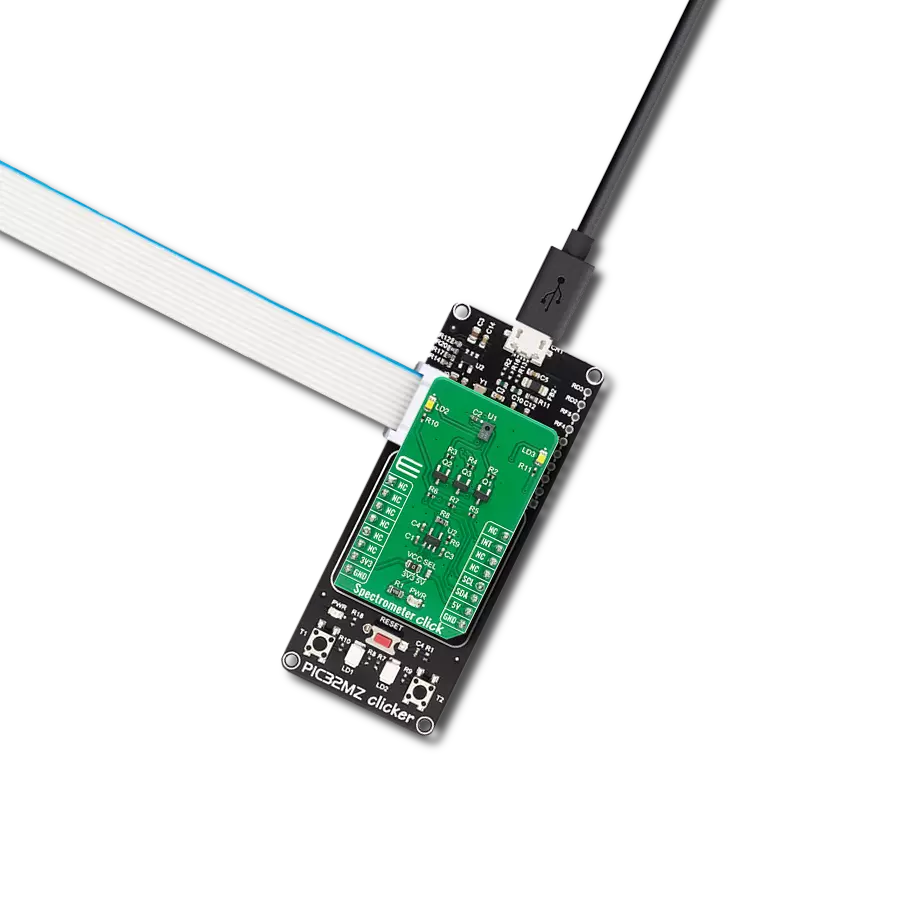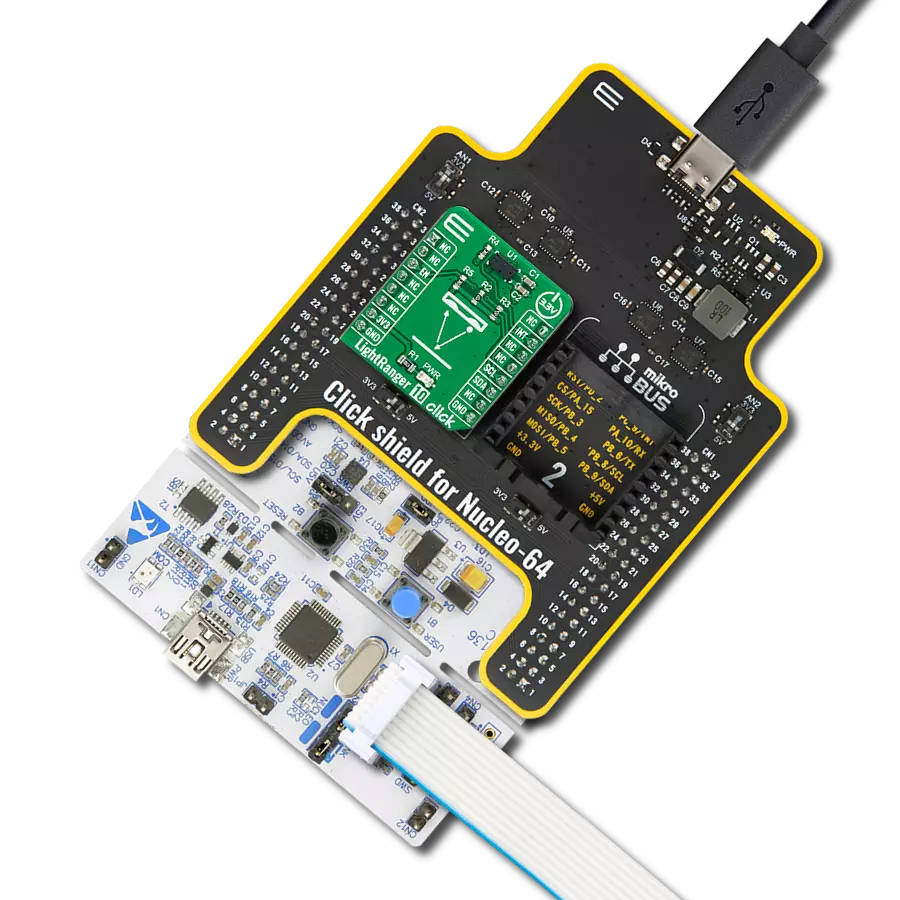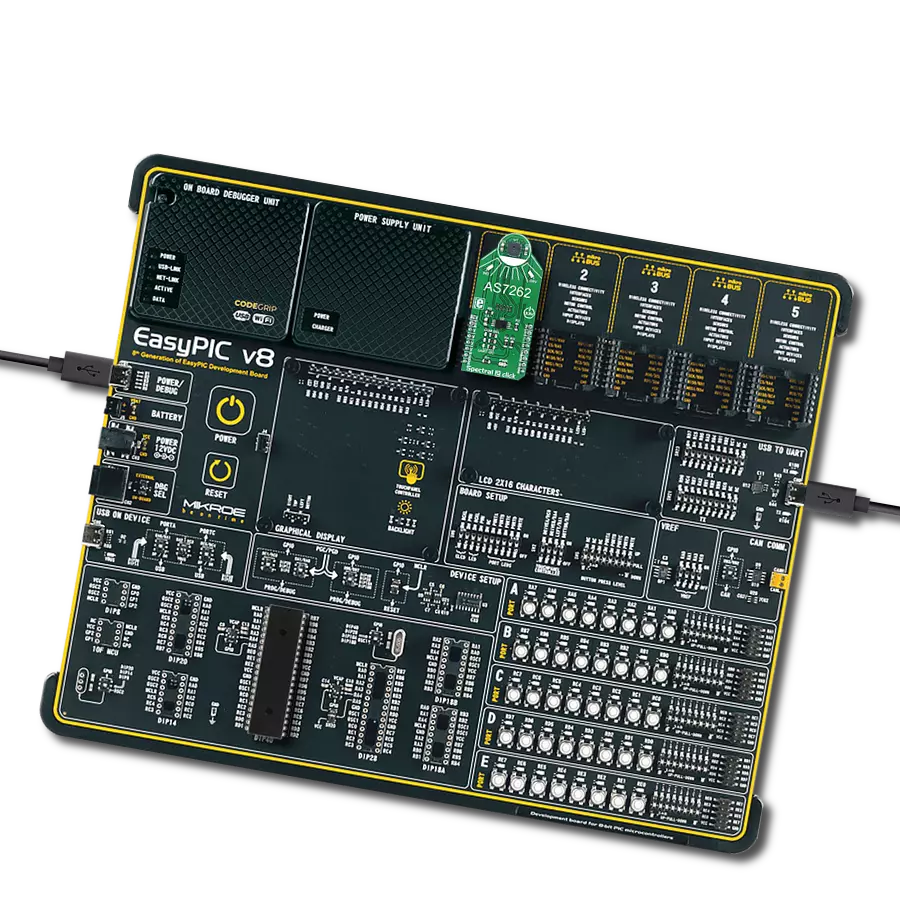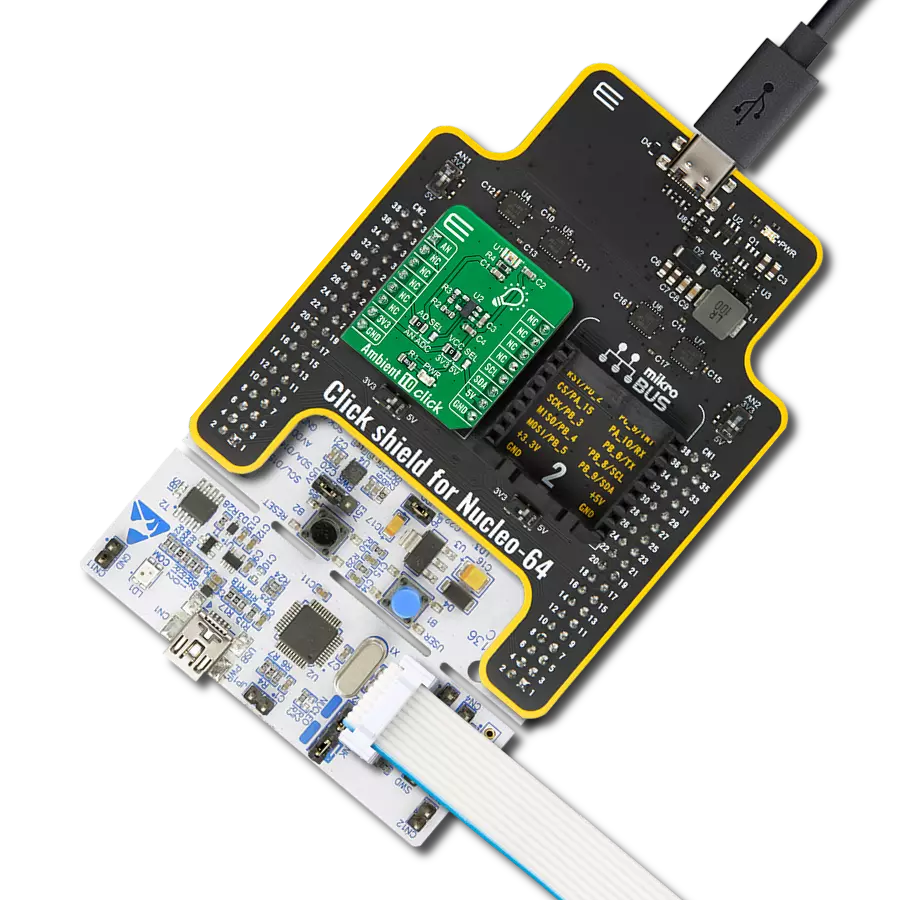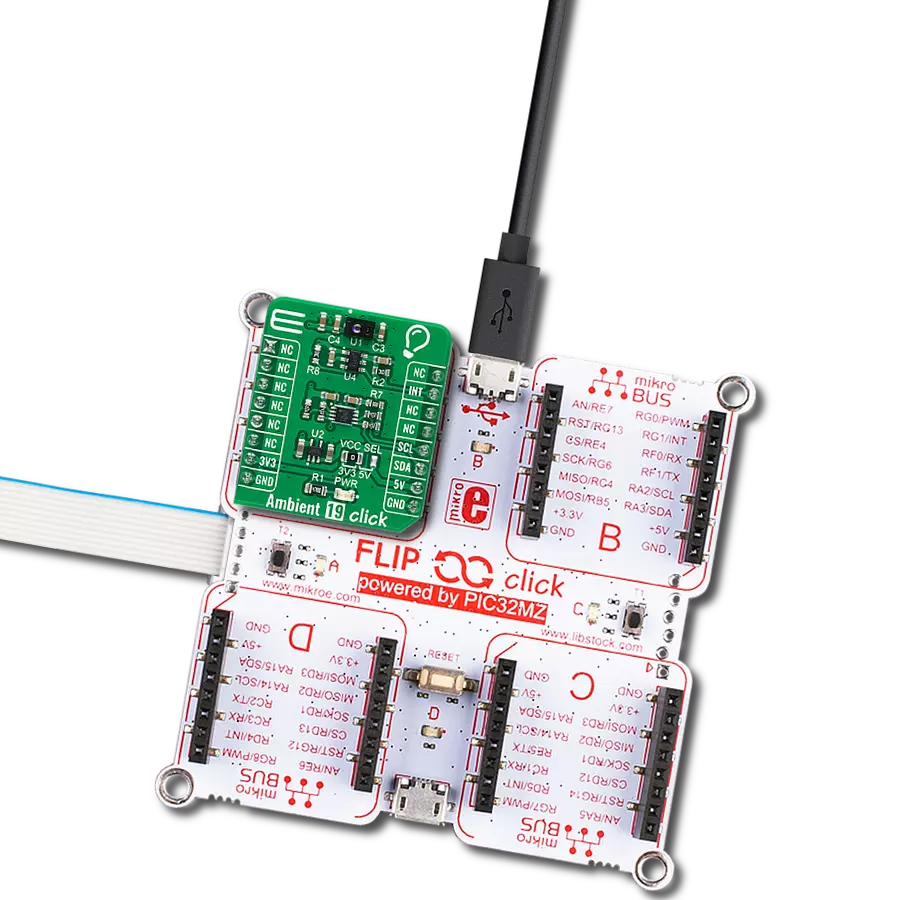Navigate with confidence in both indoor and outdoor environments, as our ToF distance sensing technology delivers unparalleled accuracy, even in challenging lighting conditions
A
A
Hardware Overview
How does it work?
LightRanger 8 Click is based on the VL53L3CX, the latest ToF ranging sensor with multi-target detection from STMicroelectronics. The VL53L3CX combines the benefits of a high-performance proximity sensor with excellent short-distance linearity, together with ranging capability up to 3m without getting affected by the target color or reflectance. It embeds third-generation FlightSense patented technology with multi-target distance measurements and automatic smudge correction. Also, it integrates a single-photon avalanche diode array and physical infrared filters to achieve the best-ranging performance in various ambient lighting conditions, with a wide range of cover glass windows. The VL53L3CX contains a laser emitter, a 940nm invisible laser, and corresponding analog drive circuitry. The laser output remains within
Class 1 laser safety limits under all reasonably foreseeable conditions, including single faults. The histogram algorithms increase cover glass crosstalk immunity and allow real-time smudge compensation, which eventually prevents external contamination from adversely affecting the ranging accuracy. With patented algorithms and ingenious module construction, the VL53L3CX can also detect various objects within the field of view. LightRanger 8 Click communicates with MCU using the standard I2C 2-Wire interface, with a clock frequency of up to 400kHz in the Fast and 1MHz in the Fast Mode Plus. Also, it provides the possibility of the device Power-Up/Boot and interrupt feature routed to the INT pin of the mikroBUS™ socket to optimize ranging operation. Once a ranging measurement is available, an interrupt is generated. The driver clears the
interrupt once the host reads the result, and the ranging sequence can repeat. If the interrupt is still present, the ranging operation inside the VL53L3CX is on hold. The interrupt behavior allows a good synchronization between the VL53L3CX and the host and avoids losing results if the host cannot acquire or process the data. On the other side, the Xshutdown pin, labeled as EN and routed to the CS pin of the mikroBUS™ socket, optimizes power consumption and is used for power on/off purposes. This Click board™ can be operated only with a 3.3V logic voltage level. The board must perform appropriate logic voltage level conversion before using MCUs with different logic levels. Also, it comes equipped with a library containing functions and an example code that can be used as a reference for further development.
Features overview
Development board
Nucleo-64 with STM32F091RC MCU offers a cost-effective and adaptable platform for developers to explore new ideas and prototype their designs. This board harnesses the versatility of the STM32 microcontroller, enabling users to select the optimal balance of performance and power consumption for their projects. It accommodates the STM32 microcontroller in the LQFP64 package and includes essential components such as a user LED, which doubles as an ARDUINO® signal, alongside user and reset push-buttons, and a 32.768kHz crystal oscillator for precise timing operations. Designed with expansion and flexibility in mind, the Nucleo-64 board features an ARDUINO® Uno V3 expansion connector and ST morpho extension pin
headers, granting complete access to the STM32's I/Os for comprehensive project integration. Power supply options are adaptable, supporting ST-LINK USB VBUS or external power sources, ensuring adaptability in various development environments. The board also has an on-board ST-LINK debugger/programmer with USB re-enumeration capability, simplifying the programming and debugging process. Moreover, the board is designed to simplify advanced development with its external SMPS for efficient Vcore logic supply, support for USB Device full speed or USB SNK/UFP full speed, and built-in cryptographic features, enhancing both the power efficiency and security of projects. Additional connectivity is
provided through dedicated connectors for external SMPS experimentation, a USB connector for the ST-LINK, and a MIPI® debug connector, expanding the possibilities for hardware interfacing and experimentation. Developers will find extensive support through comprehensive free software libraries and examples, courtesy of the STM32Cube MCU Package. This, combined with compatibility with a wide array of Integrated Development Environments (IDEs), including IAR Embedded Workbench®, MDK-ARM, and STM32CubeIDE, ensures a smooth and efficient development experience, allowing users to fully leverage the capabilities of the Nucleo-64 board in their projects.
Microcontroller Overview
MCU Card / MCU
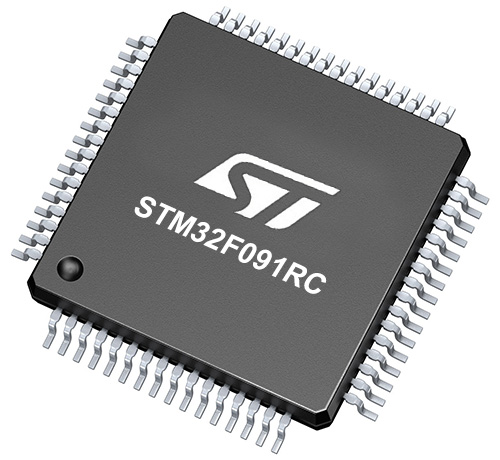
Architecture
ARM Cortex-M0
MCU Memory (KB)
256
Silicon Vendor
STMicroelectronics
Pin count
64
RAM (Bytes)
32768
You complete me!
Accessories
Click Shield for Nucleo-64 comes equipped with two proprietary mikroBUS™ sockets, allowing all the Click board™ devices to be interfaced with the STM32 Nucleo-64 board with no effort. This way, Mikroe allows its users to add any functionality from our ever-growing range of Click boards™, such as WiFi, GSM, GPS, Bluetooth, ZigBee, environmental sensors, LEDs, speech recognition, motor control, movement sensors, and many more. More than 1537 Click boards™, which can be stacked and integrated, are at your disposal. The STM32 Nucleo-64 boards are based on the microcontrollers in 64-pin packages, a 32-bit MCU with an ARM Cortex M4 processor operating at 84MHz, 512Kb Flash, and 96KB SRAM, divided into two regions where the top section represents the ST-Link/V2 debugger and programmer while the bottom section of the board is an actual development board. These boards are controlled and powered conveniently through a USB connection to program and efficiently debug the Nucleo-64 board out of the box, with an additional USB cable connected to the USB mini port on the board. Most of the STM32 microcontroller pins are brought to the IO pins on the left and right edge of the board, which are then connected to two existing mikroBUS™ sockets. This Click Shield also has several switches that perform functions such as selecting the logic levels of analog signals on mikroBUS™ sockets and selecting logic voltage levels of the mikroBUS™ sockets themselves. Besides, the user is offered the possibility of using any Click board™ with the help of existing bidirectional level-shifting voltage translators, regardless of whether the Click board™ operates at a 3.3V or 5V logic voltage level. Once you connect the STM32 Nucleo-64 board with our Click Shield for Nucleo-64, you can access hundreds of Click boards™, working with 3.3V or 5V logic voltage levels.
Used MCU Pins
mikroBUS™ mapper
Take a closer look
Click board™ Schematic

Step by step
Project assembly
Software Support
Library Description
This library contains API for LightRanger 8 Click driver.
Key functions:
lightranger8_set_measurement_timing_budget- This function sets the timing budget of the VL53Lx ranging sensorlightranger8_start_measurement- This function enables the range measuring with the adjusted intermeasurement periodlightranger8_get_distance- This function returns the corrected measured distance from the VL53Lx ranging sensor described in milimeters
Open Source
Code example
The complete application code and a ready-to-use project are available through the NECTO Studio Package Manager for direct installation in the NECTO Studio. The application code can also be found on the MIKROE GitHub account.
/*!
* @file main.c
* @brief LightRanger8 Click example
*
* # Description
* This demo application shows an example of distance
* measurement via VL53L3 ranging sensor.
*
* The demo application is composed of two sections :
*
* ## Application Init
* Initialization of I2C module, log UART and additional pins.
* After driver init, the app powers the device and performs
* default settings of the ranging sensor including distance
* mode and timing budget. The optional calibration helps
* improvement of the accuracy on the targeted distance.
* This process takes 10 second ( which can by modifed by
* simply lowering the Delay_ms ( ) value ) so the user can
* place an object on the exact location. When calibration is
* finished, device starts the measurement with intermeasurement
* period set by the user.
*
* ## Application Task
* A new data ready is checked as soon as possible which signals
* the time required for the ranging sensor to perform the
* measurement. An acqured distance is shown on the LOG with
* the 2 seconds delay so the terminal is possible to read.
*
* @author Stefan Nikolic
*
*/
#include "board.h"
#include "log.h"
#include "lightranger8.h"
static lightranger8_t lightranger8;
static log_t logger;
static int16_t offset;
static uint16_t period_ms = 100;
static uint32_t budget_us = 1000000;
static int16_t calibration_distance_mm = 100;
void application_init ( void ) {
log_cfg_t log_cfg; /**< Logger config object. */
lightranger8_cfg_t lightranger8_cfg; /**< Click config object. */
/**
* Logger initialization.
* Default baud rate: 115200
* Default log level: LOG_LEVEL_DEBUG
* @note If USB_UART_RX and USB_UART_TX
* are defined as HAL_PIN_NC, you will
* need to define them manually for log to work.
* See @b LOG_MAP_USB_UART macro definition for detailed explanation.
*/
LOG_MAP_USB_UART( log_cfg );
log_init( &logger, &log_cfg );
log_info( &logger, " Application Init " );
// Click initialization.
lightranger8_cfg_setup( &lightranger8_cfg );
LIGHTRANGER8_MAP_MIKROBUS( lightranger8_cfg, MIKROBUS_1 );
err_t init_flag = lightranger8_init( &lightranger8, &lightranger8_cfg );
if ( init_flag == I2C_MASTER_ERROR ) {
log_error( &logger, " Application Init Error. " );
log_info( &logger, " Please, run program again... " );
for ( ; ; );
}
lightranger8_power_on( &lightranger8 );
log_printf( &logger, " Wait until the configuration of the chip is completed...\r\n" );
if ( lightranger8_default_cfg( &lightranger8 ) != 0 ) {
log_error( &logger, " Sensor config error. " );
for ( ; ; );
}
lightranger8_set_distance_mode( &lightranger8, LIGHTRANGER8_DISTANCE_MODE_MEDIUM );
lightranger8_set_measurement_timing_budget( &lightranger8, budget_us );
Delay_ms ( 1000 );
log_printf( &logger, " -------------------------------------------------------------------------\r\n" );
log_printf( &logger, " For calibration place an object at %.1f cm distance from sensor.\r\n", ( float )calibration_distance_mm / 10 );
Delay_ms ( 1000 );
Delay_ms ( 1000 );
Delay_ms ( 1000 );
Delay_ms ( 1000 );
Delay_ms ( 1000 );
log_printf( &logger, " -------------------------------------------------------------------------\r\n" );
log_printf( &logger, " --------------- Sensor calibration is in progress... ---------------\r\n" );
Delay_ms ( 1000 );
Delay_ms ( 1000 );
Delay_ms ( 1000 );
Delay_ms ( 1000 );
Delay_ms ( 1000 );
lightranger8_calibrate_offset( &lightranger8, calibration_distance_mm, period_ms, &offset );
Delay_ms ( 500 );
lightranger8_start_measurement( &lightranger8, period_ms );
log_printf( &logger, " -------------------------------------------------------------------------\r\n" );
log_printf( &logger, " ------------- Sensor measurement commencing... -------------\r\n" );
Delay_ms ( 100 );
}
void application_task ( void ) {
uint16_t distance;
while ( lightranger8_get_interrupt_state( &lightranger8 ) != 0 ) {
Delay_1ms();
}
distance = lightranger8_get_distance( &lightranger8 );
log_printf( &logger, " ----------------------\r\n" );
log_printf( &logger, " Distance: %.1f cm \r\n", ( float )distance / 10 );
lightranger8_system_interrupt_clear ( &lightranger8 );
Delay_ms ( 1000 );
Delay_ms ( 1000 );
}
int main ( void )
{
/* Do not remove this line or clock might not be set correctly. */
#ifdef PREINIT_SUPPORTED
preinit();
#endif
application_init( );
for ( ; ; )
{
application_task( );
}
return 0;
}
// ------------------------------------------------------------------------ END
Additional Support
Resources
Category:Optical
